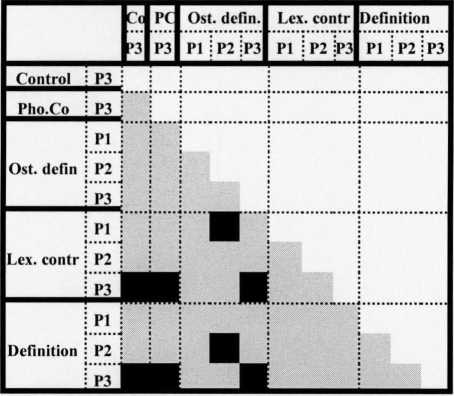Is there a differential effect of the type of exposure to new lexical items that the children
receive on the provision of contrasts?
No significant differences were found during post test 1. Significant differences were found
during post test 2 (Kruskall-Wallis I-Way Anova: X2=I 1.8, df=2, p<.005) and post test 3.
Particularly, during post test 2 the Lexical contrast and Definition groups provided
significantly more contrasts than the Ostensive definition group (Wilcoxon: Z=3.2, p<.005
and Z=2.8, p<.005 respectively). During post test 3 the Lexical contrast group provided
significantly more contrasts than the Control, Phonological control and Ostensive definition
groups (Z=3.06, p<.005; Z=3.2, p<.005; Z=3.4, p<.005).The Definition group also
performed provided significantly more contrasts than the Control, the Phonological control
and Ostensive definition groups (Wilcoxon: Z=3.03, p<.005; Z=3.1, p<.005; Z=3.4, p<.005).
Diagram 7.8 presents all the significant differences between the groups.
Diagram 7.8 Significant group differences in the provision of contrasts in the contrast
task across testing

Abbreviations: Co= Confrol; PC/ Phono-Co=Phonological control; Ostdefin=Ostensive definition; Lex. contr. Lexical contrast
Does children ,s performance on the Contrast task improve with increased exposure to the
lexical items ?
No significant differences were found over time.
253
More intriguing information
1. Policy Formulation, Implementation and Feedback in EU Merger Control2. Regulation of the Electricity Industry in Bolivia: Its Impact on Access to the Poor, Prices and Quality
3. The name is absent
4. Insecure Property Rights and Growth: The Roles of Appropriation Costs, Wealth Effects, and Heterogeneity
5. Auctions in an outcome-based payment scheme to reward ecological services in agriculture – Conception, implementation and results
6. Industrial Employment Growth in Spanish Regions - the Role Played by Size, Innovation, and Spatial Aspects
7. A simple enquiry on heterogeneous lending rates and lending behaviour
8. EU Preferential Partners in Search of New Policy Strategies for Agriculture: The Case of Citrus Sector in Trinidad and Tobago
9. The name is absent
10. Are combination forecasts of S&P 500 volatility statistically superior?